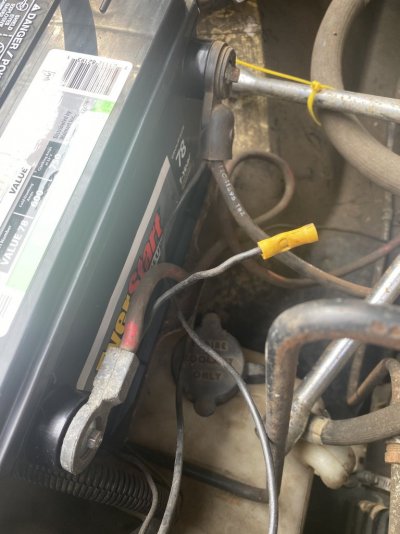That little wire is a bit small to be the alternator wire....
When it's cranking, is the starter turning AND engaging the drive/Bendix into the flywheel? Because if the starter motor is turning, but the drive is not being pushed into the flywheel gear, to turn the engine, that is likely a bad starter solenoid, or bad connection on the solenoid. With a good hot battery, it should start right up IF there are no other issues.
Once you can ascertain the starter and solenoid are working correctly, then you go on down the line, to see if you've got fire at the distributor. This truck should have the coil in cap HEI ignition. These commonly fry rotors, burning a hole through the middle where the carbon button is that the spark has to go through, from the coil,to the rotor and through it to each cylinder terminal in turn, in the firing order. Which on a Chevy V8 is 1-8-4-3-6-5-7-2.
If the rotor is bad long enough, it'll kill the coil and module too(the module and ignition pickup coil are inside the distributor, under the rotor).
I would recommend, if the starter is working properly, that you take the distributor cap off and look at the rotor. If it has much carbon or burnt marks on it, replace it! My Dad and I had many GM vehicles, mostly trucks but a few cars, and he always used Blue Streak caps and rotors. They have brass contacts instead of the aluminum ones the factory caps and rotors have. Better conductivity and don't corrode like the aluminum ones. We also had a family run auto parts store, and sold a LOT of GM ignition parts! I can still remember the part numbers: DR450X for the cap and DR318X for the rotor.
I know on a Chevy V8 the distributor is at the back of the engine and can be difficult to get to. What Dad and I came up with, was a long 2x8 board and a 2x2 piece of heavy plywood; put the board across the engine compartment (we used fender covers to pad the paint and keep the board from sliding) then lay the plywood across the board with the front close to or on the radiator support. You want this on something solid cause you'll be laying on it, to get back there. This setup let me get back there for distributor work including changing the module, and changing the high pressure fuel lines, on our square body trucks and Burbs. You also want to put a towel or blanket or another fender cover over the hood latch, cause you don't want that thing poking you!
The cap has 4 L bolts that are spring loaded, you push down on them and turn them so the L comes out from its notch on the bottom of the distributor. You'll be able to feel this with the screwdriver.
You may have to take some of the plug wires loose to move the cap assembly; it's heavy cause it has the coil in it. Mark the plug wires and any other wires that you remove, before you take them loose! There's a plug that goes into the "pan handle" of the cap, you might have to take it loose too. IIRC it only fits one way(been 10 years since I did this job!). Once you get the cap moved, the rotor is right there. It's kinda oval shape, and has 2 screws. I recommend a magnetic screwdriver or a magnet tool held next to these as you take them out; I don't remember them being staked in place and you DO NOT want to drop them down in the distributor or engine!( I've changed the cap and rotor on all 3 of my OBS trucks and the screws aren't staked in place on them.) Maybe I'm too cautious but I ain't lost one yet. The rotor has tabs on the bottom that makes it only fit properly, one way.
Hopefully this helps you get your truck going!
The rotor wearing out is a common problem. It's getting 40,000 volts shot into it by the coil, so that eventually becomes more than it can handle....


